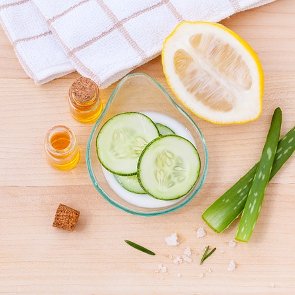5 Dos and Don’ts of Taking Care of Combination Skin
 There are plenty of articles online about taking care of dry or oily skin, but the thing is, most people actually have combination skin that is oily or prone to oiliness in the T-zone (nose and forehead) and dry or prone to dryness on the cheeks and cheekbones. Caring for this skin type may be tricky, but it’s quite manageable. Here are 5 dos and don’t of taking care of combination skin.
There are plenty of articles online about taking care of dry or oily skin, but the thing is, most people actually have combination skin that is oily or prone to oiliness in the T-zone (nose and forehead) and dry or prone to dryness on the cheeks and cheekbones. Caring for this skin type may be tricky, but it’s quite manageable. Here are 5 dos and don’t of taking care of combination skin.DO Use Gentle Facial Cleansers
Some people use harsh cleansers to control oily shine, but this approach is never any good. Harsh facial cleansers further dehydrate dry patches, leading to redness, itching and flaking, and make oily patches produce even more sebum to lock in moisture. As a result, they make things worse instead of balancing the skin. Gentle cleansers, on the other hand, are perfect for combination skin. If you have more dry than oily patches, opt for a cleansing lotion or cream; if you have more oily patches than dry, pick a low-pH cleansing gel.
Check this out: 5 Ingredients to Avoid in Your Face Wash
DO Pick the Right Active Ingredients
Each cosmetic product contains active ingredients that perform a particular task. You should choose products containing the ingredients that address your most common skin issues. For example, vitamin C and arbutin fight dull complexion and pigmentation, alpha hydroxy acids (AHAs) improve skin texture and help eliminate comedones, retinol prevents premature wrinkles, etc. Please read the instructions carefully before applying the product. Some products can be applied all over the face, while others are spot treatments.
Check this out: 5 Pairs of Skincare Ingredients That Work Well Together
DO Buy a Moisturizer with Water Retaining Ingredients
To keep your skin hydrated, you need a moisturizer that contains water retaining ingredients, for example, hyaluronic acid or lactic acid. Such ingredients are called humectants. They draw moisture from the air and lock it in. If your skin lacks moisture in winter, you need a moisturizer with occlusives and emollients that protect and nourish the skin (ceramides, carrier oils, NMF). Keep in mind that the texture of a cosmetic product doesn’t necessarily depend on its ingredients, but thick creams usually contain more oils and waxes than light creams and gels.
Check this out: How to Choose the Right Moisturizer for Combination Skin
DON’T Apply Clay Masks All Over Your Face
Clay masks are a great way to control oily shine, soothe inflammation, and get rid of blackheads and pimples. Unfortunately, they also make dry skin even drier. If you have combination skin, you should apply clay masks to your T-zone but not to your cheeks, especially if the skin there is dry, tight and flaky.
Check this out: 5 Clay Face Mask Recipes for Clear and Glowing Skin
DON’T Use Aggressive Products to Control Oil Production
As we’ve already mentioned above, many people with oily or combination skin use aggressive products (for example, alcohol-based toners) to control oil production and balance the skin. However, it never works. Such products dehydrate the skin and stress it out. As a response, sebaceous glands start producing even more skin oil to provide necessary hydration and protection. “Gentle” doesn’t mean “ineffective”. There are plenty of products and ingredients that do their job without stripping your skin of moisture and protection, you just need to find the right ones.
Check this out: 8 Effective Ingredients for Oily Skin
Breadcrumbs
Filters
- Face
Tags
Related Articles
- Skin Benefits of Sea Buckthorn, 6 Benefits of Olive Squalane for Your Skin, 5 DIY Face Mask Recipes for Fresh and Glowing Skin, 6 Tips for Taking Care of Problem Skin